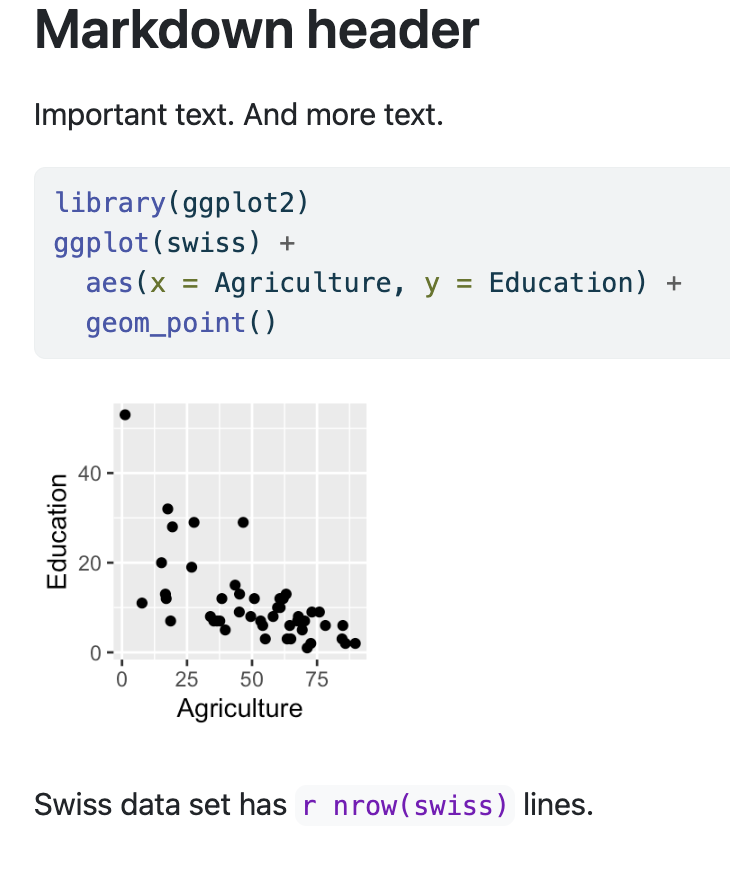(2:6)**3[1] 8 27 64 125 216Quarto
Rworkshop
Monday, 10 February 2025
So you run a computational workflow to ensure reproducibility and then type up the results?
knitrQuarto is a tool expanding .Rmd (RMarkdown documents)
Credit: Alison Horst
<h1></h1> in HTMLHTML example
<!DOCTYPE html>
<html>
<body>
<h1>This is a heading</h1>
<p>This is some text in a paragraph.</p>
</body>
</html>#)Markdown
# This is a heading
This is some text in a paragraph.#, ##, ### …**This will be bold**)*This will be italic*)http://example.com is auto-linked[description](http://example.com)code (`coding stuff`)
```
This is *verbatim* code
# Even headers are not interpreted
```
rendered as:
This is *verbatim* code
# Even headers are not interpreted
---
YAML header
---
Markdown elements
Code chunks in R (or Python)
Markdown elements with inline R code
The swiss set has `r nrow(swiss)` rows.is rendered as:
The swiss set has 47 rows.
Inline foot notes^[This is the foot note].$$
\phi = \frac{1+\sqrt{5}}{2}
$$is rendered as: \[ \phi = \frac{1+\sqrt{5}}{2} \]
This appears in $\phi = (1+\sqrt{5})/2$ text.This appears in \(\phi = (1+\sqrt{5})/2\) text.
{fig-align="left" width=400}

See documentation
Key | Description
---:|------------
One | rownames
Rows| `r nrow(swiss)`produces
| Key | Description |
|---|---|
| swiss | Data set of provinces |
| Has | rownames |
| Rows | 47 |
Fertility Agriculture Examination Education Catholic
Courtelary 80.2 17.0 15 12 9.96
Delemont 83.1 45.1 6 9 84.84
Franches-Mnt 92.5 39.7 5 5 93.40
Moutier 85.8 36.5 12 7 33.77
Neuveville 76.9 43.5 17 15 5.16
Porrentruy 76.1 35.3 9 7 90.57
Broye 83.8 70.2 16 7 92.85
Glane 92.4 67.8 14 8 97.16
Gruyere 82.4 53.3 12 7 97.67
Sarine 82.9 45.2 16 13 91.38
Veveyse 87.1 64.5 14 6 98.61
Aigle 64.1 62.0 21 12 8.52
Aubonne 66.9 67.5 14 7 2.27
Avenches 68.9 60.7 19 12 4.43
Cossonay 61.7 69.3 22 5 2.82
Echallens 68.3 72.6 18 2 24.20
Grandson 71.7 34.0 17 8 3.30
Lausanne 55.7 19.4 26 28 12.11
La Vallee 54.3 15.2 31 20 2.15
Lavaux 65.1 73.0 19 9 2.84
Morges 65.5 59.8 22 10 5.23
Moudon 65.0 55.1 14 3 4.52
Nyone 56.6 50.9 22 12 15.14
Orbe 57.4 54.1 20 6 4.20
Oron 72.5 71.2 12 1 2.40
Payerne 74.2 58.1 14 8 5.23
Paysd'enhaut 72.0 63.5 6 3 2.56
Rolle 60.5 60.8 16 10 7.72
Vevey 58.3 26.8 25 19 18.46
Yverdon 65.4 49.5 15 8 6.10
Conthey 75.5 85.9 3 2 99.71
Entremont 69.3 84.9 7 6 99.68
Herens 77.3 89.7 5 2 100.00
Martigwy 70.5 78.2 12 6 98.96
Monthey 79.4 64.9 7 3 98.22
St Maurice 65.0 75.9 9 9 99.06
Sierre 92.2 84.6 3 3 99.46
Sion 79.3 63.1 13 13 96.83
Boudry 70.4 38.4 26 12 5.62
La Chauxdfnd 65.7 7.7 29 11 13.79
Le Locle 72.7 16.7 22 13 11.22
Neuchatel 64.4 17.6 35 32 16.92
Val de Ruz 77.6 37.6 15 7 4.97
ValdeTravers 67.6 18.7 25 7 8.65
V. De Geneve 35.0 1.2 37 53 42.34
Rive Droite 44.7 46.6 16 29 50.43
Rive Gauche 42.8 27.7 22 29 58.33
Infant.Mortality
Courtelary 22.2
Delemont 22.2
Franches-Mnt 20.2
Moutier 20.3
Neuveville 20.6
Porrentruy 26.6
Broye 23.6
Glane 24.9
Gruyere 21.0
Sarine 24.4
Veveyse 24.5
Aigle 16.5
Aubonne 19.1
Avenches 22.7
Cossonay 18.7
Echallens 21.2
Grandson 20.0
Lausanne 20.2
La Vallee 10.8
Lavaux 20.0
Morges 18.0
Moudon 22.4
Nyone 16.7
Orbe 15.3
Oron 21.0
Payerne 23.8
Paysd'enhaut 18.0
Rolle 16.3
Vevey 20.9
Yverdon 22.5
Conthey 15.1
Entremont 19.8
Herens 18.3
Martigwy 19.4
Monthey 20.2
St Maurice 17.8
Sierre 16.3
Sion 18.1
Boudry 20.3
La Chauxdfnd 20.5
Le Locle 18.9
Neuchatel 23.0
Val de Ruz 20.0
ValdeTravers 19.5
V. De Geneve 18.0
Rive Droite 18.2
Rive Gauche 19.3Not ready for your publication!
gt table package| Province | Fertility | Agriculture | Examination | Education | Catholic | Infant.Mortality |
|---|---|---|---|---|---|---|
| Courtelary | 80.2 | 17.0 | 15 | 12 | 9.96 | 22.2 |
| Delemont | 83.1 | 45.1 | 6 | 9 | 84.84 | 22.2 |
| Franches-Mnt | 92.5 | 39.7 | 5 | 5 | 93.40 | 20.2 |
| Moutier | 85.8 | 36.5 | 12 | 7 | 33.77 | 20.3 |
| Neuveville | 76.9 | 43.5 | 17 | 15 | 5.16 | 20.6 |
| Porrentruy | 76.1 | 35.3 | 9 | 7 | 90.57 | 26.6 |
| Broye | 83.8 | 70.2 | 16 | 7 | 92.85 | 23.6 |
| Glane | 92.4 | 67.8 | 14 | 8 | 97.16 | 24.9 |
| Gruyere | 82.4 | 53.3 | 12 | 7 | 97.67 | 21.0 |
| Sarine | 82.9 | 45.2 | 16 | 13 | 91.38 | 24.4 |
as_tibble(swiss, rownames = "Province") |>
slice_head(n = 10) |>
gt() |>
tab_options(table.font.size = 16) |>
tab_style(list(style = cell_text(size = 20,
weight = "bold",
color = "white"),
cell_fill(color = "#00A4E1")),
locations = cells_column_labels(columns = everything()))| Province | Fertility | Agriculture | Examination | Education | Catholic | Infant.Mortality |
|---|---|---|---|---|---|---|
| Courtelary | 80.2 | 17.0 | 15 | 12 | 9.96 | 22.2 |
| Delemont | 83.1 | 45.1 | 6 | 9 | 84.84 | 22.2 |
| Franches-Mnt | 92.5 | 39.7 | 5 | 5 | 93.40 | 20.2 |
| Moutier | 85.8 | 36.5 | 12 | 7 | 33.77 | 20.3 |
| Neuveville | 76.9 | 43.5 | 17 | 15 | 5.16 | 20.6 |
| Porrentruy | 76.1 | 35.3 | 9 | 7 | 90.57 | 26.6 |
| Broye | 83.8 | 70.2 | 16 | 7 | 92.85 | 23.6 |
| Glane | 92.4 | 67.8 | 14 | 8 | 97.16 | 24.9 |
| Gruyere | 82.4 | 53.3 | 12 | 7 | 97.67 | 21.0 |
| Sarine | 82.9 | 45.2 | 16 | 13 | 91.38 | 24.4 |
The most common open format for references.
BibTeX example
@article{gerard2018,
author = {Gérard, Deborah and Schmidt, Florian and Ginolhac, Aurélien and Schmitz, Martine and Halder, Rashi and Ebert, Peter and Schulz, Marcel H and Sauter, Thomas and Sinkkonen, Lasse},
title = "{Temporal enhancer profiling of parallel lineages identifies AHR and GLIS1 as regulators of mesenchymal multipotency}",
journal = {Nucleic Acids Research},
volume = {47},
number = {3},
pages = {1141-1163},
year = {2018},
month = {12},
issn = {0305-1048},
doi = {10.1093/nar/gky1240},
url = {https://doi.org/10.1093/nar/gky1240},
eprint = {https://academic.oup.com/nar/article-pdf/47/3/1141/27897368/gky1240.pdf},
}bibliography: mybib.bib@gerard2018 in the body of the manuscript.This will generate a reference in the text and include a reference section at the end of your document.
Example
---
title: "Our research"
format: html
bibliography: mybib.bib
csl: nature.csl
---
ChiP-seq peaks were discovered[@gerad2018].HTML is the easiest, best supported and most useful display format
revealjs allows to create presentations\(LaTeX\) generates PDF , which might be preferred in some application
HTML output can be printed and thereby converted to PDF
Word (.docx) and Powerpoint (.pptx) output exists
Aurélien Ginolhac (Uni Luxembourg)
More in the official Quarto Presentation demo and available code
Thank you for your attention!
